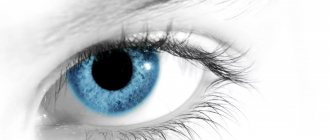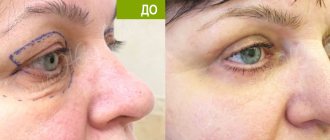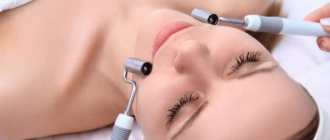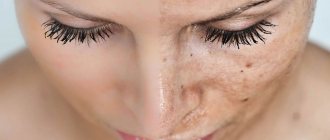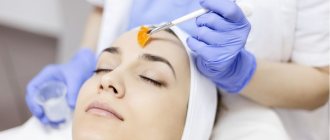Eyes are the mirror of the soul. A person’s appearance largely depends on their condition. If many wrinkles have formed around the eyes, there is ptosis of the upper or lower eyelid, as well as bruises and hernias under the eyes, then only plastic surgery will help correct the situation.
Blepharoplasty is one of the most popular aesthetic surgeries among patients, which is performed at Dr. Lelikov’s plastic surgery clinic. Thanks to his experience, the surgeon can eliminate even the most pronounced age-related changes in the skin around the eyes.
Do you want to do circular, transconjunctival or laser lower or upper plastic surgery, but don’t know what the eyelids look like after blepharoplasty - photos of patients published on the website of Dr. Lelikov’s plastic surgery clinic are the best answer to this question. Reviews from our clients will convince you of the importance of this operation, and prices in Moscow vary depending on the type of operation: upper, lower or circular blepharoplasty;
Indications for upper blepharoplasty
Upper eyelid blepharoplasty can be performed at any age. To perform the operation, one of the following conditions is sufficient:
- Presence of fatty hernias above the eyes. Under the skin above the eyes, many people often have heavy ridges that cover the entire eyelid, visually narrowing the eye and making the look gloomy;
- The presence of severe ptosis (sagging skin on the upper eyelids). This situation may arise due to the aging process of the body, or due to genetic predisposition.
Indications for blepharoplasty include both aesthetic imperfections and general medical problems. For example, ptosis of the skin on the upper eyelids caused by age-related changes can interfere with normal vision and contribute to poor vision.
Lower blepharoplasty: effect on the face
If you are undergoing eye surgery for lower eyelid hernias or wrinkles, we recommend looking at photos of patients after transconjunctival blepharoplasty. You can find on the website of the plastic surgery clinic both photos after lower blepharoplasty by day, and a comparison “before and after” of aesthetic surgery.
Also in our gallery you can see photos of scars after blepharoplasty - they are almost invisible, which is confirmed by the experience of plastic surgeon Lelikov.
If you want blepharoplasty of the upper or lower eyelids with a traditional or transconjunctival approach without complications after aesthetic surgery, see real photos of patients after eyelid surgery and read reviews about the surgeon’s qualifications. The information presented on the site is objective, which means that you can make an appointment with plastic surgeon Lelikov for surgical correction of the upper or lower eyelids for hernias, wrinkles and ptosis.
Contraindications to upper blepharoplasty
Contraindications to blepharoplasty include only serious systemic diseases:
- Oncology;
- Diseases of the cardiovascular system;
- Impaired liver and kidney function;
- Poor blood clotting.
As for eye diseases, almost none of them are considered contraindications to surgery. The exception is inflammatory diseases such as conjunctivitis. It is worth noting that a temporary contraindication for surgery is any inflammatory process in the body.
How does healing proceed after blepharoplasty?
Patients who decide to improve their appearance and refresh their eyes with the help of blepharoplasty are always interested in the rehabilitation process and its duration.
This question is one of the main ones for potential patients who are still just thinking about the possibility of surgery. Related questions also arise. How soon will it be possible to go back to work? Will the scars be noticeable? When can you wear contact lenses? What means can you use to quickly get rid of swelling? How long will it take for final healing? In this article, we will describe in detail how rehabilitation proceeds after blepharoplasty of the upper eyelids and transconjunctival plastic surgery of the lower eyelids, and we will give answers to your questions. And in conclusion, we will offer tips that will help speed up rehabilitation after blepharoplasty.
How long is the standard rehabilitation period?
Blepharoplasty is a relatively simple and low-traumatic operation. The risk of complications is minimal, they practically do not happen. The standard rehabilitation period is only 14-16 days. For many patients who strictly follow the plastic surgeon’s recommendations, the postoperative rehabilitation period is reduced to 10 days.
The healing process after blepharoplasty is somewhat prolonged due to the following factors:
- patient age over 45 years;
- there is a tendency to edema;
- the skin is thick;
- there are individual characteristics of the skin in the eye area that prolong the rehabilitation process;
- the patient smokes.
After upper blepharoplasty and transconjunctival lower eyelid surgery, a hospital stay is not required. The patient can go home immediately. Relatives are advised to meet him in a private car or take a taxi, since the eyes are not fully open immediately after the operation and the gaze may become blurred.
Painful sensations after this operation are either absent or insignificant and can be easily relieved with painkillers prescribed by the doctor.
Natural consequences of blepharoplasty during the healing period
During postoperative rehabilitation, the patient may experience:
- moderate swelling;
- small bruises localized under the lower eyelids;
- feeling of heaviness of eyelids;
- increased lacrimation;
- dry eyes;
- soreness;
- blurred vision;
- diplopia (double vision).
We emphasize that the patient does not always experience all these side effects. Usually only a few symptoms from the lists appear.
These side effects of blepharoplasty usually go away within 7-10 days. Residual swelling can persist for up to two months, depending on the individual tissue response to the new location. Proper skin care, which we will discuss below, helps to quickly solve the problem of residual edema.
Will there be scars after blepharoplasty?
This is probably the most common question that plastic surgeon patients ask. There is no need to worry about scarring, since the surgeon makes incisions in natural folds of the skin. There is a stereotype that the seams are less noticeable if blepharoplasty is done using a laser. But that's not true. When using a laser, the edge of the wound is burned, which makes the scar more noticeable than when using a super-sharp scalpel. In general, the quality of the postoperative scar depends on the skill of the plastic surgeon and the individual characteristics of the patient’s skin.
Rehabilitation calendar
1 day. You can go home immediately after the operation. It is recommended to apply cold to the eyelids to reduce swelling. It is worth taking a painkiller. 2-3 days. You can take a shower and even wash your hair (be careful not to get shampoo in your eyes). Use antiseptic drops prescribed by your doctor and do recommended eye exercises. You can read a little, but in moderation so as not to overload your eyes. 3-5 days. Visit a clinic to have your stitches removed (if they are not self-dissolving). You can wear contact lenses. Day 6 All antiseptic stickers (plasters) are removed from the eyelids. Day 7 Most patients experience bruising and swelling. As a rule, the patient returns to normal life and goes to work. Day 10 Traces of hemorrhage are reduced to a minimum. If there are no complications, you can use decorative cosmetics (it is advisable to choose products for sensitive eyes). Day 14 You can gradually resume your usual physical activities. 45-60 days. Residual edema disappears completely. Post-operative scars become completely invisible even without decorative cosmetics. The effect of eyelid surgery becomes clearly visible.
What is prohibited and what is not recommended to do during the rehabilitation period?
To ensure healing is as successful as possible, follow these simple recommendations:
- do not drink alcohol or smoke (strictly prohibited);
- do not eat salty, sour, spicy foods during the rehabilitation period;
- protect your eyes from sunlight and wind for six months (this can be done with glasses);
- after the operation, get plenty of rest and avoid physical exertion, especially those that increase intraocular pressure (lifting heavy objects, bending over);
- refrain from intense exercise for a month;
- for several days, try not to watch TV, use a computer or read (this causes dry eyes);
- try not to cry or blink frequently;
- do not sleep with your head down;
- Do not take too hot a bath or go to the sauna.
How to reduce swelling after blepharoplasty?
To ensure that swelling goes away as quickly as possible after surgery, follow these recommendations for caring for the skin around the eyes:
- I need to remove the special tape applied to ensure the correct placement of the tissues;
- regularly use medications prescribed by your doctor (ointment, eye drops);
- apply cold compresses to the eye area;
- sleep with your head elevated;
- drink more water;
- Perform the exercises recommended by your doctor to restore muscle activity in the eye area, eliminate lymph congestion and improve blood circulation.
To quickly relieve residual swelling, 7-14 days after surgery you can sign up at a cosmetology clinic for lymphatic drainage massage, moisturizing treatments and lifting. Botox to smooth out facial wrinkles can be done 1.5-2 months after eyelid surgery.
The information on the site was personally verified by plastic surgeon Maxim Aleksandrovich Osin; if you have any additional questions, call the phone number listed on the site.
How is the operation performed?
A plastic surgeon can perform blepharoplasty in two ways - using a laser or classically (using a scalpel). Both of these methods have the same number of advantages. Laser surgery does not imply the complete absence of bruises, swelling and postoperative stitches. If an operation was performed on the body, especially with the removal of excess tissue, then there will be stitches, swelling and bruises regardless of how it was performed.
Laser is considered a new, more convenient way to perform surgery. For the surgeon, it is of great importance whether the operation is performed with a laser or scalpel. The patient will not notice any difference if blepharoplasty was performed by a competent and qualified surgical team.
The operation is performed under local (very rarely general) anesthesia with intravenous sedation. The incision during upper blepharoplasty runs along the natural crease of the eyelid, so those faint scars that the operation will leave behind will be additionally hidden. In order for anyone to be able to see these scars, they need to be specifically demonstrated.
When performing blepharoplasty, the doctor performs the following manipulations (one or all):
- Excision of excess skin (a small oval-shaped area is removed);
- Plastic surgery of the eyelid muscles. It involves either partial displacement of the muscle to the upper position, or excision of its excess;
- Removal of excess fatty tissue.
The duration of upper blepharoplasty is 1-2 hours.
Stages
How to apply stitches after eyelid surgery
Upper eyelid surgery in progress
Removal of excess skin of the upper eyelid
Coagulation of blood vessels during surgery
Blepharoplasty is usually performed under local anesthesia. The patient experiences absolutely no pain.
The duration of the operation ranges from 30 minutes to 2 hours.
Directly in the operating room, markings are applied to the skin of the eyelid with a special marker. This is one of the most important stages of blepharoplasty, since the result depends on the correct identification of problems and ways to eliminate them.
The next stage is surgery. An incision is made, excess skin and fatty tissue are excised, and if necessary, cosmetic stitches are applied. The incision is made in the natural crease of the eyelid and along the eyelash edge, so the likelihood of scars is minimal.
The seam line is sealed with a thin strip of special adhesive tape. This completes the operation. You can go home one hour after surgery.
After 5 days, the stitches must be removed. The recovery period takes 10-15 days. You will be able to see the final result of the work in 1.5–4 months.
The recovery process after blepharoplasty directly depends on strict adherence to all the recommendations of the plastic surgeon.
How long does it take to heal after upper blepharoplasty?
After the operation, the patient's eyelids are hidden under bandages, but this does not prevent most patients from seeing the result immediately after the procedure.
Bruising and swelling are the first things that scare patients after blepharoplasty, but this is a normal reaction of the body to any surgical intervention. The swelling increases in the first couple of days, and in the next two weeks it completely subsides, the bruises disappear even earlier. The skin on the eyelids is very thin, so it heals quickly, and after two weeks patients are allowed to use cosmetics.
Thin scars after blepharoplasty become barely noticeable 1-2 months after the procedure, and after six months there is no trace left of them.
In the first week after blepharoplasty, you should treat your eyes very carefully - hide them from exposure to sunlight under dark glasses, and do not wet the operated area for at least 3-4 days after surgery. You should wash with tampons moistened with soft water. To make swelling go away faster, you need to apply ice compresses.
Swelling and bruising after blepharoplasty
After almost any operation, swelling and bruising occur in the area of surgical trauma due to the intersection of blood and lymphatic vessels. All patients are concerned about the question of when the swelling and bruising will go away after blepharoplasty, how long they last and how to remove them. As can be seen from the rehabilitation calendar, during the first 3 days the swelling increases and then begins to gradually subside. By 2-3 weeks, most patients already have a presentable appearance. The swelling completely subsides by 6 months. A number of remedies can help remove dark circles under the eyes and swelling:
Lyoton
Gel for external use.
Direct anticoagulant for external use, which has a local antithrombotic, antiexudative, moderate anti-inflammatory effect, accelerates the processes of resorption of hematomas and blood clots and reduces tissue swelling.
traumeel
Ointment for external use. A multicomponent homeopathic medicine, the effect of which is determined by the components included in its composition.
troxevasin
Troxevasin® is a flavonoid (rutin derivative). Has P-vitamin activity; has venotonic, venoprotective, decongestant, anti-inflammatory, anticoagulant and antioxidant effects. Reduces the permeability and fragility of capillaries, increases their tone.
Advantages and disadvantages
Blepharoplasty allows you to quickly solve existing problems. At the same time, the result is high-quality and long-term, since the surgeon eliminates imperfections rather than masks them.
It is also important that after blepharoplasty there are practically no traces left. The seams are very difficult to distinguish.
Many patients note improved vision (as visual obstructions are eliminated).
Manipulation also has its disadvantages. For example, blepharoplasty sometimes requires concomitant eyebrow correction.
Some people consider the recovery period to be a disadvantage. But it cannot be avoided. And if you strictly follow the doctor’s recommendations, it will pass without complications.
Before the operation you must:
Undergo a clinical and laboratory examination prescribed by your attending physician.
The day before and on the day of surgery, do not use any cosmetics (eye cream, face cream, lipstick, etc.), or perfume.
Avoid alcohol three days before surgery.
2 weeks before surgery, exclude lemon and all aspirin-containing drugs, as well as any anticoagulants from food.
On the eve of the operation, you should wash your hair and face. Wash thoroughly immediately before surgery.
Three days before surgery, take Dicinon - 2 tablets 3 times a day, as well as another tablet in the morning on the day of surgery.
On the day of the operation, come to the clinic at the appointed time.
Summary
Blepharoplasty is an operation that allows you to eliminate almost any imperfection of the eyelids. It is quite safe and gives high-quality long-term results.
However, do not forget that:
- Before the operation, you must come for a consultation with a specialist and familiarize yourself with the list of contraindications.
- You need to understand that there are exceptions to any rule. And in rare cases, blepharoplasty may not give the result you were hoping for.
- You must follow all the surgeon’s recommendations before and after surgery.
And most importantly: if in doubt, don’t be afraid to ask questions. I will be happy to answer them online or in consultations.
Can vision deteriorate after blepharoplasty?
No. Plastic surgery of the upper eyelids, on the contrary, will improve vision - in the event that drooping eyelids interfere with normal vision.
Brief visual disturbances after surgery are normal and are associated with swelling at the surgical site. It goes away a few days later, when the process of active recovery begins. Sometimes in the first 2-3 days, patients notice that they see double, the picture is unclear - this is also a short-term phenomenon that is considered normal.
Immediately after surgery:
You may feel a slight painful sensation, reminiscent of a burning sensation in the eyelids under the rays of the scorching sun. During this period (when the effect of the anesthetic wears off), you lie on your back for 2 hours with ice packs on your eyelids, which eliminates pain and prevents the development of bruises. If necessary, pain medications may be administered, which is usually not required, but can be done at the request of the patient.
After the operation, the surgeon will examine you and give you the necessary recommendations.
Do not remove the gauze bandages placed on your eyelids after surgery yourself.
